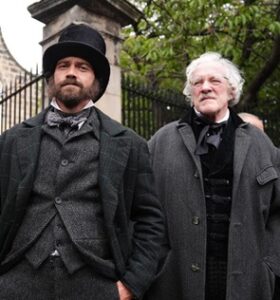Frankenstein
Guillermo del Toro has made a career of making motion pictures about fairy tale monsters. But not monster movies like the teenage horror flick du jour. No, del Toro’s body of work includes very well-written, adult films featuring relatable human characters and intriguing plot development. The fact that monsters are in the mix is almost secondary.
Past work
Take his 2017 Oscar-winner “The Shape of Water.” Sally Hawkins’ mute cleaning lady character befriends a supposedly horrible and scary creature brought to her high-security government laboratory by Michael Shannon’s evil colonel, who wants to exploit and “study” him. Yes, the “creature” is some sort of humanoid amphibian, but it could just as well be a rare animal bought to the lab from deep within the African veldt. The story would still work.
Likewise, del Toro’s 2021 offering “Nightmare Alley” centers around sideshow carnival workers and the strange circus creatures prevalent in pre-television Americana. It’s always something unknown and a little macabre with del Toro. That’s what we expect. And that’s what we get.
 Logical choice
Logical choice
So, it would only make logical sense that del Toro would desire to adapt Mary Shelley’s 1818 novel “Frankenstein” for the umpteenth time. With modern technology at his disposal, del Toro could obviously improve upon James Whale’s 1931 most-famous version – the campy Universal monster movie which stars Boris Karloff as the Frankenstein Monster. He would also likely improve upon any of the subsequent remakes or films centered around the Frankenstein story.
Is it necessary?
But much as with Steven Spielberg’s 2021 remake of “West Side Story,” I have to ask the simple question… Why? Spielberg’s version is excellent. It made my Top Ten List that year. But, other than using a cast of actual Latinos to play the Puerto Rican characters, I’m not sure it’s necessary.
I feel the same way here. It is true that del Toro’s version is not campy and is more true to the source material that the Karloff version – which was relegated to the weekend late-night horror film library practically from the dawn of television. But is it necessary? What does del Toro bring to the Frankenstein story that we didn’t know already?
Strong cast
Del Toro’s “Frankenstein” stars the still underrated actor Oscar Isaac as the lead character – here, portrayed less as a mad scientist and more as a brilliant surgeon dead set on conquering death by reanimating deceased bodies. Still outside the mainstream of scientific thought, but more palpable than the deranged doctor character we’re used to. Jacob Elordi (“Saltburn,” Elvis in “Priscilla”) gives the monster a heart and soul not present in Karloff’s sleepwalking zombie. The setup is intriguing.
 And we are privy to more of Dr. Frankenstein’s backstory here. Veteran British actor Charles Dance stars as the young doctor’s demanding and overpowering father during the early childhood scenes. Christoph Waltz is almost unrecognizable (but isn’t he always?) as the wealthy financier who believes in Frankenstein’s work and funds his experiment. Felix Kammerer plays Frankenstein’s younger brother, and Mia Goth his fiancée, who is not intimidated by the talented doctor, and not afraid to call him out on the scientific logic she finds murky at best.
And we are privy to more of Dr. Frankenstein’s backstory here. Veteran British actor Charles Dance stars as the young doctor’s demanding and overpowering father during the early childhood scenes. Christoph Waltz is almost unrecognizable (but isn’t he always?) as the wealthy financier who believes in Frankenstein’s work and funds his experiment. Felix Kammerer plays Frankenstein’s younger brother, and Mia Goth his fiancée, who is not intimidated by the talented doctor, and not afraid to call him out on the scientific logic she finds murky at best.
Too much gore
Where del Toro goes wrong is in the presentation of Frankenstein’s work. Taking a cue from the Yorgos Lanthimos playbook, del Toro subjects us to close-ups of Frankenstein sawing the legs of deceased bodies, simmering flesh, and enough bloodletting to populate an entire series of war movies. The gross-out factor has always been one of my chief criticisms of Lanthimos; and even “Poor Things” (his most accessible film) featured too much of it.
Over the top
I feared going into this adaptation that del Toro would overdue the gore, and he does. In fact, everything in “Frankenstein” is over the top. When Dr. Frankenstein realizes his experiment has produced a monster given to violence, he burns down the castle with the monster in it. Yes, that’s a part of the narrative. But the execution is almost comically excessive, replete with the uncomfortable screams of the monster as his flesh sizzles and sears. And when the monster confronts anyone he considers an enemy, he is given to throwing them against the nearest wall. But how many bodies breaking glass do we need to see to comprehend the monster’s strength? Also, I’m not sure why del Toro chooses to re-set Shelley’s story in 1855, four years after she died.
Not a bad film at all
“Frankenstein” is not a bad film. In fact, it’s extremely well-made and Dan Laustsen’s cinematography is top-notch, as usual. But it’s almost too slick, too gory, and too downright exhausting. If you don’t feel mentally and physically drained after sitting through this adaptation, you haven’t been paying attention. This isn’t a film you’ll soon forget – even though you may want to.
Only for the true fans
Which brings me back to my original point: Is this really necessary? I love that the monster here is relatable. He’s “practically human,” as we often like to say. I love that the doctor isn’t some raging madman. But, so what? If you’re a huge fan of the Frankenstein story and have a desire to gobble up all things related to Frankenstein, by all means see this film. But if you only have a passing interest, as I do, skip it.
Andy Ray‘s reviews also appear on https://townepost.com/tag/film-reviews/